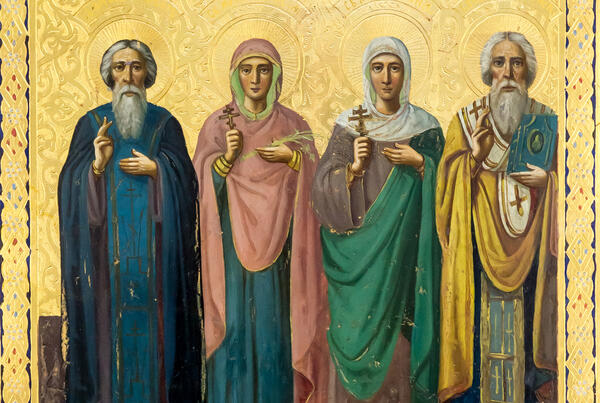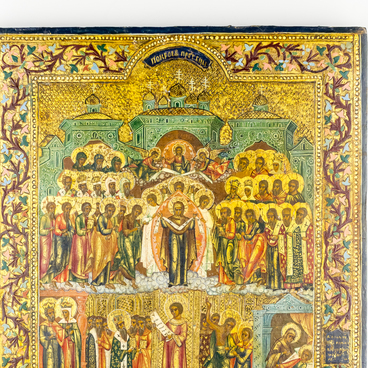People began to commission icons with selected saints a long time ago: usually the client chose several righteous people that were important to him to be depicted in one work. Such icons could be painted for churches on special occasions: for example, in honor of the consecration of a chapel or for some unusual holiday. Also, icons with selected saints were ordered in large quantities by families: for weddings and other celebrations, as well as uniting all the patrons of the family in one icon.
Icons with patron saints occupy an important place among such items. The word “patron” is translated from Latin and means “guardian”. Usually, the saint, whose name the believer received at baptism, became the spiritual patron of the person.
It is often difficult to understand on which icons with selected saints the patrons of specific people are depicted. Accurate information can be found only by studying documents and records. Unfortunately, the icon from the museum collection did not have any inscription with the history of its creation. Therefore, the researchers failed to establish for what needs it was created: to be put in a revered place at home, where the icons of the family iconostasis were kept, for example the icons of the Savior, the Most Holy Theotokos and patron saints of all family members) or for the church.
However, scientists are still inclined to believe that the icon was given as a gift to a particular family, and featured its patrons. The saints are depicted in pairs: two male and two female figures. On the sides, the icon painter placed St. Basil the Great and Paul the Confessor: the first is dressed in bishop’s vestments with a baptized omophorion, the second wears a monastic robe. The female images are the martyrs Tatiana and Anastasia with crosses.
Even in the icon painting of the 16th–17th centuries, a special type of icon with full-length patron saints was common, when figures occupy almost the entire space of the inner field (ark). Most often, such products were created for the peasants. In the 17th–19th centuries, provincial, including northern, icon painting was actively developing, peasants became the main customers of icons in these regions.
In the works of rural masters, you can often see the proximity of subtle artistic techniques to the handicraft approach. The icon from the museum collection also combines several heterogeneous features. The artist chose a noble gold background and embossed a three-dimensional pattern. The faces are drawn subtly and vividly, but at the same time the pictorial volumes are painted in a rather simplified, flat manner.
Icons with patron saints occupy an important place among such items. The word “patron” is translated from Latin and means “guardian”. Usually, the saint, whose name the believer received at baptism, became the spiritual patron of the person.
It is often difficult to understand on which icons with selected saints the patrons of specific people are depicted. Accurate information can be found only by studying documents and records. Unfortunately, the icon from the museum collection did not have any inscription with the history of its creation. Therefore, the researchers failed to establish for what needs it was created: to be put in a revered place at home, where the icons of the family iconostasis were kept, for example the icons of the Savior, the Most Holy Theotokos and patron saints of all family members) or for the church.
However, scientists are still inclined to believe that the icon was given as a gift to a particular family, and featured its patrons. The saints are depicted in pairs: two male and two female figures. On the sides, the icon painter placed St. Basil the Great and Paul the Confessor: the first is dressed in bishop’s vestments with a baptized omophorion, the second wears a monastic robe. The female images are the martyrs Tatiana and Anastasia with crosses.
Even in the icon painting of the 16th–17th centuries, a special type of icon with full-length patron saints was common, when figures occupy almost the entire space of the inner field (ark). Most often, such products were created for the peasants. In the 17th–19th centuries, provincial, including northern, icon painting was actively developing, peasants became the main customers of icons in these regions.
In the works of rural masters, you can often see the proximity of subtle artistic techniques to the handicraft approach. The icon from the museum collection also combines several heterogeneous features. The artist chose a noble gold background and embossed a three-dimensional pattern. The faces are drawn subtly and vividly, but at the same time the pictorial volumes are painted in a rather simplified, flat manner.



